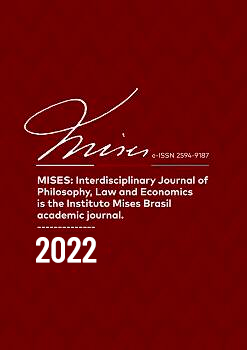Conectando la teoría del consumidor y la teoría cuantitativa del dinero
un enfoque de Cantillon
DOI:
https://doi.org/10.30800/mises.2022.v10.1450Palabras clave:
teoría del consumidor, efecto Cantillon, TQM, elasticidad de la oferta monetaria a nivel de precios al consumidor, no neutralidad monetariaResumen
Este ensayo muestra una conexión entre la teoría del consumidor y la teoría cuantitativa del dinero, inspirado en el enfoque de Richard Cantillon, en el que los cambios en el stock de dinero influyen en los niveles de precios, caracterizando la elasticidad de la oferta de dinero en relación con el nivel de precios al consumidor. Así, cambios en la oferta monetaria generan cambios en el nivel de precios, y tales efectos monetarios afectan la elección óptima del consumidor si el cambio en la oferta monetaria afecta los precios de dos bienes con diferente intensidad. Cuando el gobierno expande la cantidad de dinero en la economía, afecta los precios relativos y, en consecuencia, cambia las decisiones de los agentes económicos en una economía de mercado. Con base en datos trimestrales estadounidenses, 1946:04 a 2019:04, los resultados empíricos muestran que el cambio en el stock de dinero afecta directamente el cambio óptimo en el consumo e indirectamente afecta el cambio óptimo en el consumo a través del cambio en los precios relativos, mostrando que el dinero no es neutral.
Descargas
Citas
BERG, Richard van den. Richard Cantillon's Early Monetary Views? Economic Thought, v. 1, p. 48-79, 2012. Available in: https://www.semanticscholar.org/paper/Richard-Cantillon%E2%80%99s-Early-Monetary-Views-Berg/6f1943067faf73b4a565962abd7fa77ec910bf10 Acessed: 25 set. 2022.
BERG, Richard van den. Circular reasoning. Forbonnais and the intricate history of circular flow analysis in the 1750s. The European Journal of the History of Economic Thought, 2019. https://doi.org/10.1080/09672567.2019.1635180 DOI: https://doi.org/10.1080/09672567.2019.1635180
BLAUG, Mark. Why is the quantity theory of money the oldest surviving theory in economics? In: BLAUG, Mark (Org.). Quantity theory of money from Locke to Keynes and Friedman. Hants, England: Edward Elgar Publishing Limited, 1995. p. 27-49.
BORDO, Michael D. Some aspects of the monetary economics of Richard Cantillon. Journal of Monetary Economics, v. 12, n. 2 (August), p. 235-258, 1993. https://doi.org/10.1016/0304-3932(83)90002-8 DOI: https://doi.org/10.1016/0304-3932(83)90002-8
BROWN, Christopher; Thornton, Mark. How entrepreneurship theory created economics. The Quarterly Journal of Austrian Economics, v.16, n. 4, 2013. Available in: https://mises.org/library/how-entrepreneurship-theory-created-economics Acessed: 25 set. 2022.
CANTILLON, Richard. An essay on economic theory: an english translation of Richard Cantillon's essai sur la nature du commerce en général. Translated by Chantal Saucier and Edited by Mark Thornton. Auburn: The Ludwig von Mises Institute, 2010.
CHENA, Langnan; HUANG, Shoufeng. Transmission effects of foreign exchange reserves on price level: evidence from China. Economics Letters, v. 117, n. 3, December, 2012. https://doi.org/10.1016/j.econlet.2012.06.037 DOI: https://doi.org/10.1016/j.econlet.2012.06.037
DERKSEN, S.; KESELMAN, H. Backward, forward and stepwise automated subset selection algorithms: frequency of obtaining authentic and noise variables. British Journal of Mathematical and Statistical Psychology, v. 45, 1992. https://doi.org/10.1111/j.2044-8317.1992.tb00992.x DOI: https://doi.org/10.1111/j.2044-8317.1992.tb00992.x
HÉBERT, Robert F. Richard Cantillon's Early Contributions to Spatial Economics. Economica, New Series, v. 48, n. 189, p. 71-77, 1981. https://doi.org/10.2307/2552944 DOI: https://doi.org/10.2307/2552944
HONE, Joseph. Richard Cantillon, economist: biographical note. The Economic Journal, v. 54, n. 213, (Apr.), p. 96-100, 1944. https://doi.org/10.2307/2959833 DOI: https://doi.org/10.2307/2959833
HUMPHREY, T. F. Wicksell on the quantity theory. Federal Reserve Bank of Richmond. Quarterly, v. 83, n. 4, 1997. Available in: https://www.richmondfed.org/-/media/richmondfedorg/publications/research/economic_quarterly/1997/fall/pdf/humphrey.pdf Acessed: 25 set. 2022.
HURVICH, C. M.; TSAI, C. L. The impact of model selection on inference in linear regression. American Statistician, v. 44, p. 214-217, 1990. https://doi.org/10.1080/00031305.1990.10475722 DOI: https://doi.org/10.1080/00031305.1990.10475722
KOENKER, Roger; BASSETT JR., Gilbert. Regression quantilies. Econometrica, v. 46, n.1, p. 33-50, 1978. https://doi.org/10.2307/1913643 DOI: https://doi.org/10.2307/1913643
MURPHY, Antoin E. Richard Cantillon: banker and economist. The Journal of Libertarian Studies, v. 7, n. 2, Fall, 1985. Available in: https://cdn.mises.org/7_2_1_0.pdf Acessed: 25 set. 2022.
MOREIRA, Tito Belchior Silva; TABAK, Benjamin Miranda; MENDONÇA, Mario Jorge; SACHSIDA, Adolfo. An evaluation of the non-neutrality of money. Plos One, March, 2016. https://doi.org/10.1371/journal.pone.0145710 DOI: https://doi.org/10.1371/journal.pone.0145710
PESARAN, M. H.; SHIN, Y. An autoregressive distributed-lag modelling approach to cointegration analysis. Econometric Society Monographs, v. 31, p. 371-413, 1998. https://doi.org/10.1017/CBO9781139052221.011 DOI: https://doi.org/10.1017/CBO9781139052221.011
PESARAN, M. H.; SHIN, Y.; SMITH, R. J. Bounds testing approaches to the analysis of level relationships. Journal of Applied Econometrics, v. 16, n. 3, p. 289-326, 2001. https://doi.org/10.1002/jae.616 DOI: https://doi.org/10.1002/jae.616
ROECKER, E. B. Prediction error and its estimation for subset-selection models. Technometrics, v. 33, p. 459-469, 1991. https://doi.org/10.1080/00401706.1991.10484873 DOI: https://doi.org/10.1080/00401706.1991.10484873
ROTHBARD, Murray N. Economic thought before Adam Smith: an Austrian perspective on the history of economic thought. Aldershot, England: Edward Elgar Publishing, 1995. v. 1
SIERON, A. The non-price effects of monetary inflation. The Quarterly Journal of Austrian Economics, v. 20, n. 2, 2017. Available in: https://mises.org/library/non-price-effects-monetary-inflation Acessed: 25 set. 2022.
SPENGLER, Joseph J. Richard Cantillon: first of the moderns I. Journal of Political Economy, v. 62, n. 4, p. 281-295, 1954a. https://doi.org/10.1086/257535 DOI: https://doi.org/10.1086/257535
SPENGLER, Joseph J. Richard Cantillon: first of the moderns II. Journal of Political Economy, v. 62, n. 5, p. 406-424, 1954b. https://doi.org/10.1086/257574 DOI: https://doi.org/10.1086/257574
THORNTON, Mark. Was Richard Cantillon a mercantilist? Journal of the History of Economic Thought, v. 29, n. 4, 2008. https://doi.org/10.1080/10427710701666495 DOI: https://doi.org/10.1080/10427710701666495
THORNTON, Mark. Cantillon and the invisible hand. The Quarterly Journal of Austrian Economics, v. 12, n. 2, p. 27-46, 2009. Available in: https://citeseerx.ist.psu.edu/viewdoc/download?doi=10.1.1.169.3656&rep=rep1&type=pdf Acessed: 25 set. 2022.
VAN DEN BERG, R. Richard Cantillon's early monetary views? Economic Thought, v. 1, n.1, p. 48-79, 2012a. Available in: http://et.worldeconomicsassociation.org/papers/richardcantillons-early-monetary-views/ Acessed: Jan 10 2022.
VAN DEN BERG, R. Something wonderful and incomprehensible in their economy: the English versions of Richard Cantillon's essay on the nature of trade in general. European Journal of the History of Economic Thought, v. 19, n. 6, p. 868-907, 2012b. https://doi.org/10.1080/09672567.2012.735683 DOI: https://doi.org/10.1080/09672567.2012.735683
Descargas
Publicado
Cómo citar
Número
Sección
Licencia
Derechos de autor 2022 MISES: Interdisciplinary Journal of Philosophy, Law and Economics

Esta obra está bajo una licencia internacional Creative Commons Atribución 4.0.

Este periódico está licenciado sob uma Creative Commons Attribution 4.0 International License.


















